California State University: 2008 Financial and Economic Crisis Report
VerifiedAdded on 2022/08/29
|9
|1913
|20
Report
AI Summary
This report provides an in-depth analysis of the 2008 financial and economic crisis, examining its origins in the deregulation of the financial sector and the subprime mortgage market. It explores the role of investment banks, the housing sector, and the securitization of loans. The report discusses the implications of the crisis on macroeconomic factors, including employment, income inequality, and international trade. It highlights the crisis's spread from the USA to other countries, particularly those in Europe, and the impact on global financial markets. The analysis draws on sources like the movie 'Inside Job' and a chapter from an international economics textbook to provide a comprehensive overview of the crisis, its causes, and its consequences. The report also touches upon the ineffectiveness of the deregulation policy and the role of credit rating agencies and the challenges faced by the international economy. The report concludes that the crisis led to significant economic downturn and affected many key macroeconomic indicators.
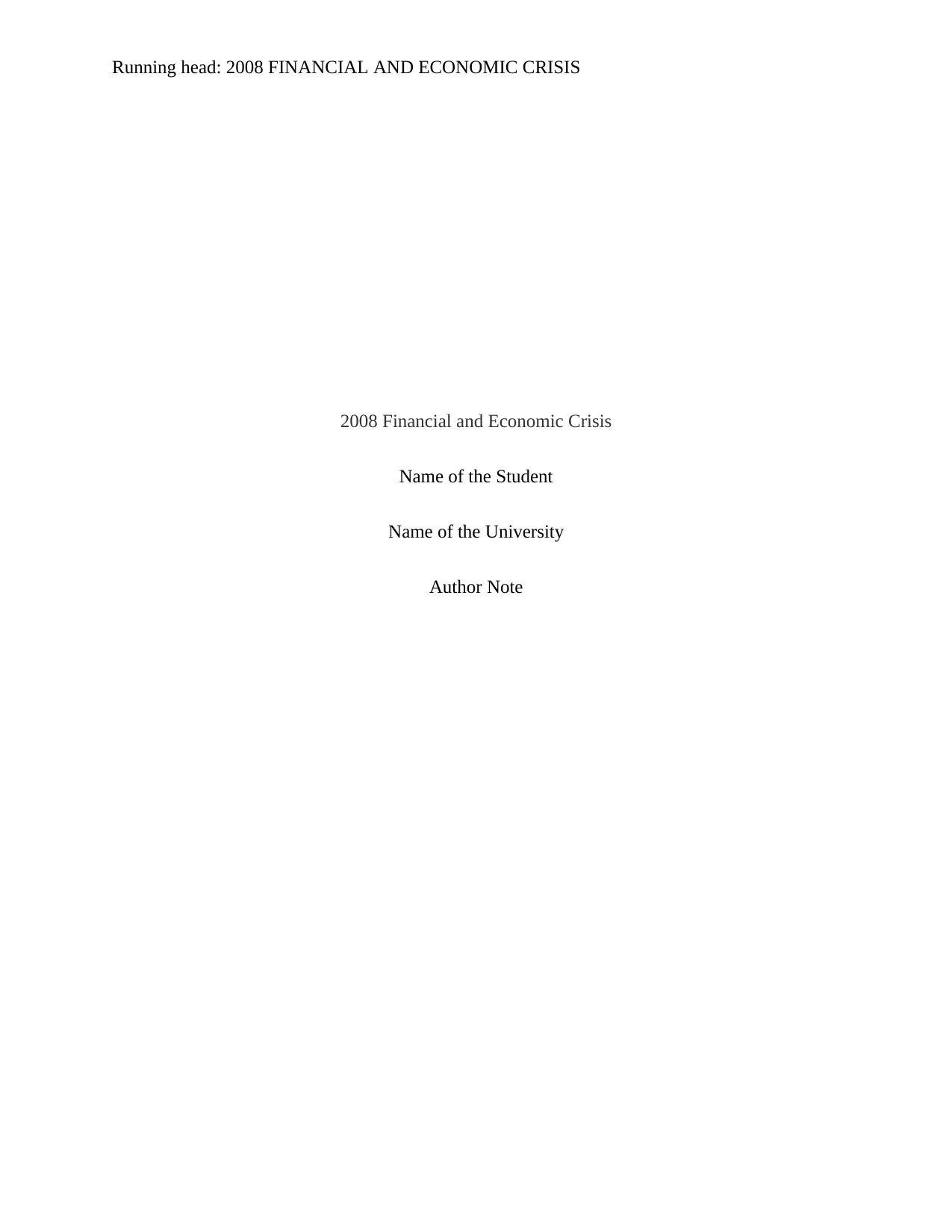
Running head: 2008 FINANCIAL AND ECONOMIC CRISIS
2008 Financial and Economic Crisis
Name of the Student
Name of the University
Author Note
2008 Financial and Economic Crisis
Name of the Student
Name of the University
Author Note
Paraphrase This Document
Need a fresh take? Get an instant paraphrase of this document with our AI Paraphraser
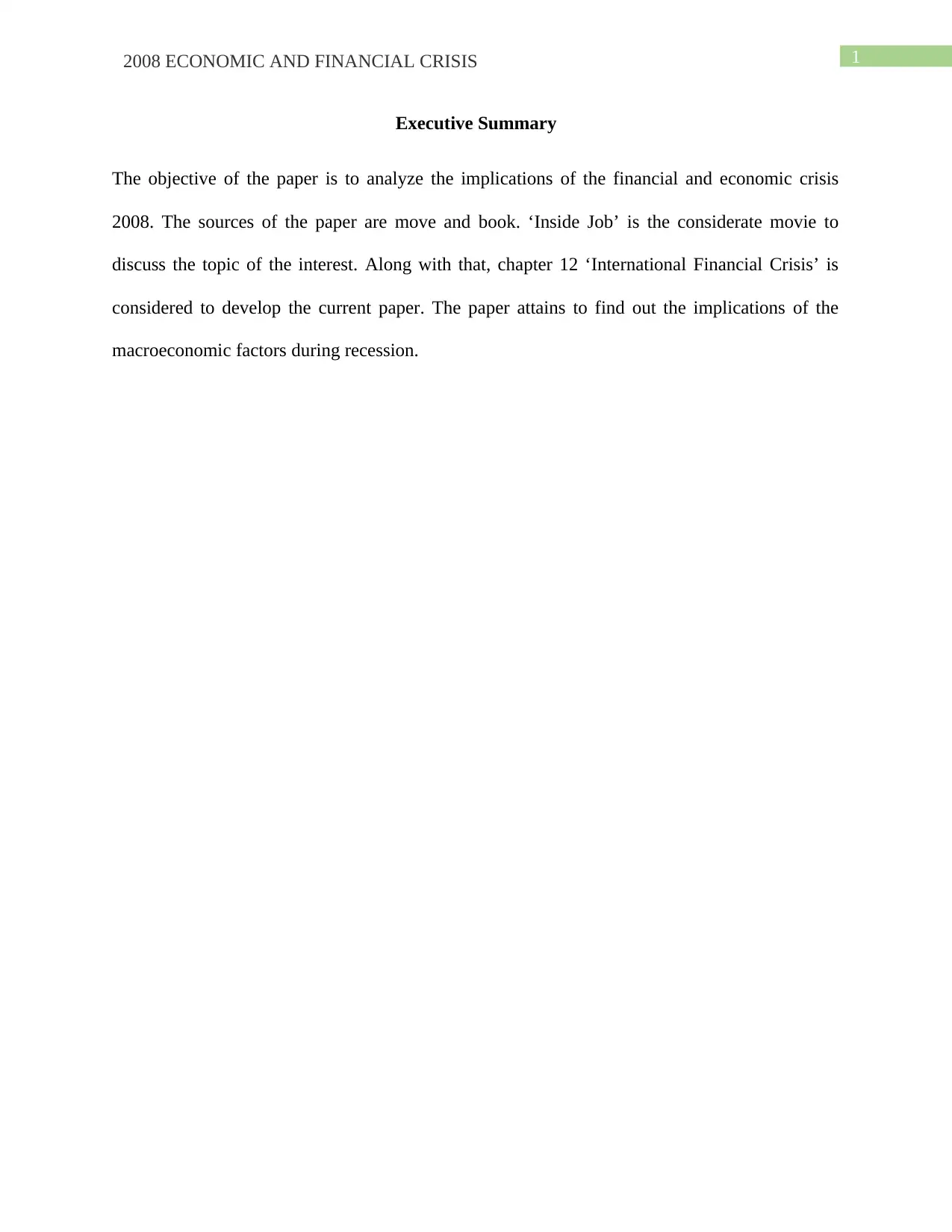
12008 ECONOMIC AND FINANCIAL CRISIS
Executive Summary
The objective of the paper is to analyze the implications of the financial and economic crisis
2008. The sources of the paper are move and book. ‘Inside Job’ is the considerate movie to
discuss the topic of the interest. Along with that, chapter 12 ‘International Financial Crisis’ is
considered to develop the current paper. The paper attains to find out the implications of the
macroeconomic factors during recession.
Executive Summary
The objective of the paper is to analyze the implications of the financial and economic crisis
2008. The sources of the paper are move and book. ‘Inside Job’ is the considerate movie to
discuss the topic of the interest. Along with that, chapter 12 ‘International Financial Crisis’ is
considered to develop the current paper. The paper attains to find out the implications of the
macroeconomic factors during recession.
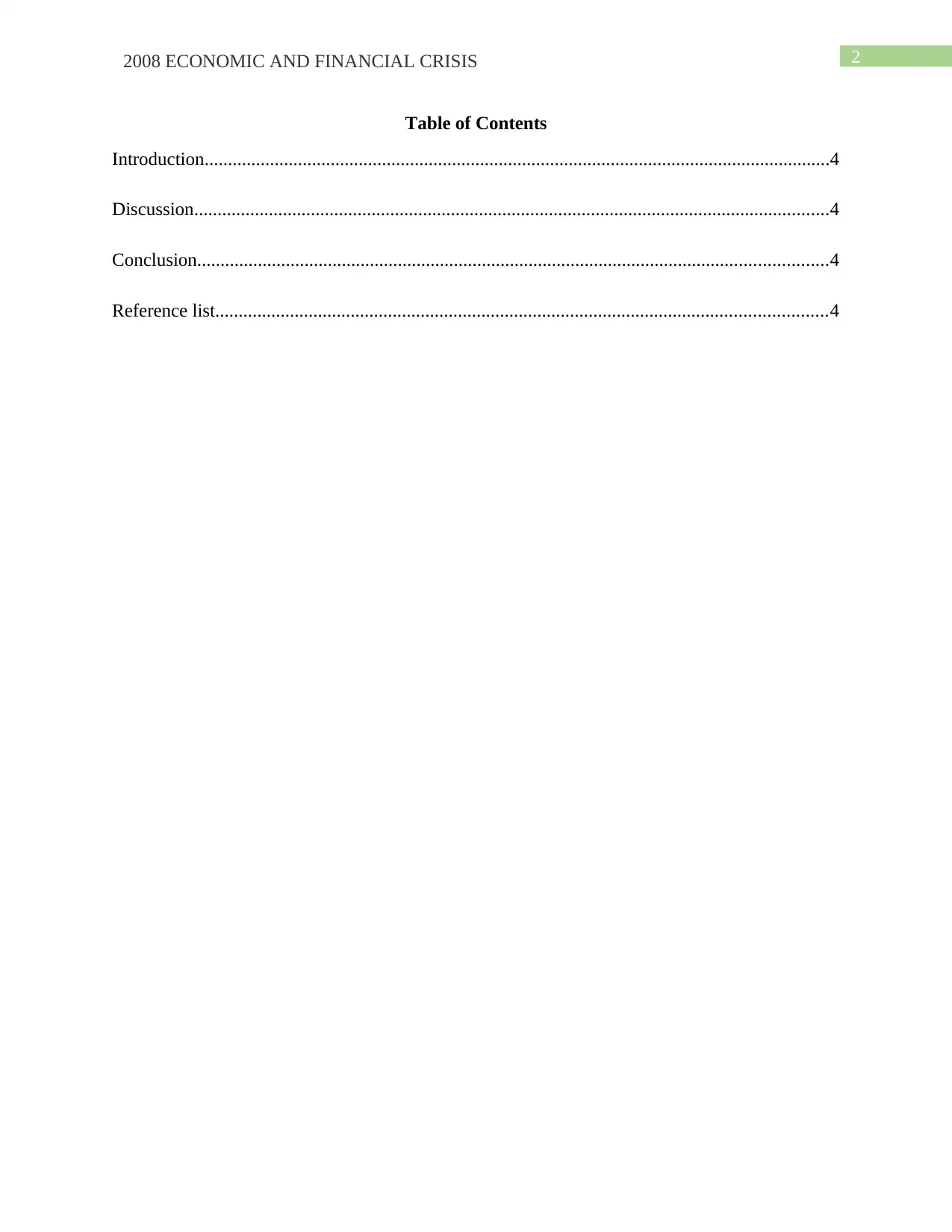
22008 ECONOMIC AND FINANCIAL CRISIS
Table of Contents
Introduction......................................................................................................................................4
Discussion........................................................................................................................................4
Conclusion.......................................................................................................................................4
Reference list...................................................................................................................................4
Table of Contents
Introduction......................................................................................................................................4
Discussion........................................................................................................................................4
Conclusion.......................................................................................................................................4
Reference list...................................................................................................................................4
⊘ This is a preview!⊘
Do you want full access?
Subscribe today to unlock all pages.

Trusted by 1+ million students worldwide
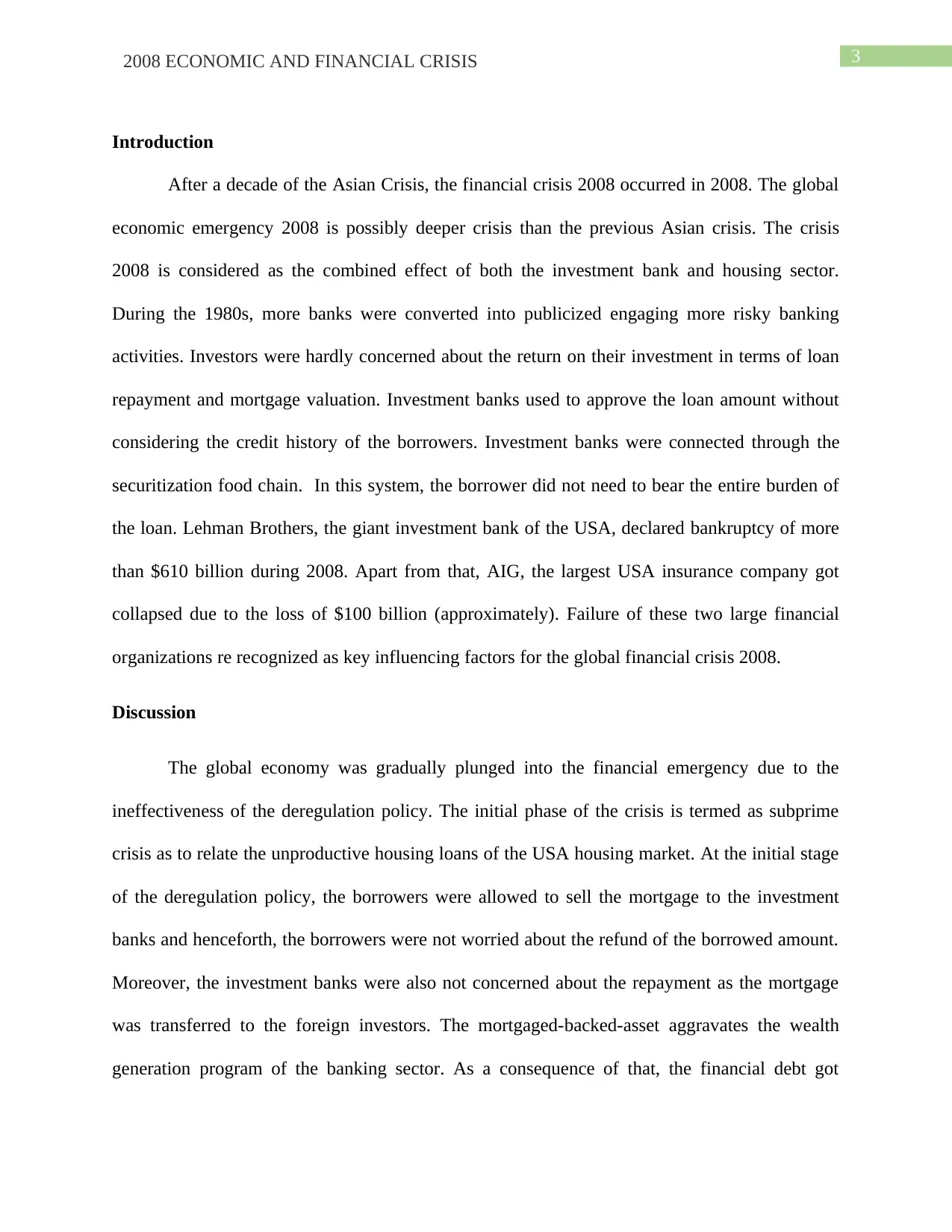
32008 ECONOMIC AND FINANCIAL CRISIS
Introduction
After a decade of the Asian Crisis, the financial crisis 2008 occurred in 2008. The global
economic emergency 2008 is possibly deeper crisis than the previous Asian crisis. The crisis
2008 is considered as the combined effect of both the investment bank and housing sector.
During the 1980s, more banks were converted into publicized engaging more risky banking
activities. Investors were hardly concerned about the return on their investment in terms of loan
repayment and mortgage valuation. Investment banks used to approve the loan amount without
considering the credit history of the borrowers. Investment banks were connected through the
securitization food chain. In this system, the borrower did not need to bear the entire burden of
the loan. Lehman Brothers, the giant investment bank of the USA, declared bankruptcy of more
than $610 billion during 2008. Apart from that, AIG, the largest USA insurance company got
collapsed due to the loss of $100 billion (approximately). Failure of these two large financial
organizations re recognized as key influencing factors for the global financial crisis 2008.
Discussion
The global economy was gradually plunged into the financial emergency due to the
ineffectiveness of the deregulation policy. The initial phase of the crisis is termed as subprime
crisis as to relate the unproductive housing loans of the USA housing market. At the initial stage
of the deregulation policy, the borrowers were allowed to sell the mortgage to the investment
banks and henceforth, the borrowers were not worried about the refund of the borrowed amount.
Moreover, the investment banks were also not concerned about the repayment as the mortgage
was transferred to the foreign investors. The mortgaged-backed-asset aggravates the wealth
generation program of the banking sector. As a consequence of that, the financial debt got
Introduction
After a decade of the Asian Crisis, the financial crisis 2008 occurred in 2008. The global
economic emergency 2008 is possibly deeper crisis than the previous Asian crisis. The crisis
2008 is considered as the combined effect of both the investment bank and housing sector.
During the 1980s, more banks were converted into publicized engaging more risky banking
activities. Investors were hardly concerned about the return on their investment in terms of loan
repayment and mortgage valuation. Investment banks used to approve the loan amount without
considering the credit history of the borrowers. Investment banks were connected through the
securitization food chain. In this system, the borrower did not need to bear the entire burden of
the loan. Lehman Brothers, the giant investment bank of the USA, declared bankruptcy of more
than $610 billion during 2008. Apart from that, AIG, the largest USA insurance company got
collapsed due to the loss of $100 billion (approximately). Failure of these two large financial
organizations re recognized as key influencing factors for the global financial crisis 2008.
Discussion
The global economy was gradually plunged into the financial emergency due to the
ineffectiveness of the deregulation policy. The initial phase of the crisis is termed as subprime
crisis as to relate the unproductive housing loans of the USA housing market. At the initial stage
of the deregulation policy, the borrowers were allowed to sell the mortgage to the investment
banks and henceforth, the borrowers were not worried about the refund of the borrowed amount.
Moreover, the investment banks were also not concerned about the repayment as the mortgage
was transferred to the foreign investors. The mortgaged-backed-asset aggravates the wealth
generation program of the banking sector. As a consequence of that, the financial debt got
Paraphrase This Document
Need a fresh take? Get an instant paraphrase of this document with our AI Paraphraser
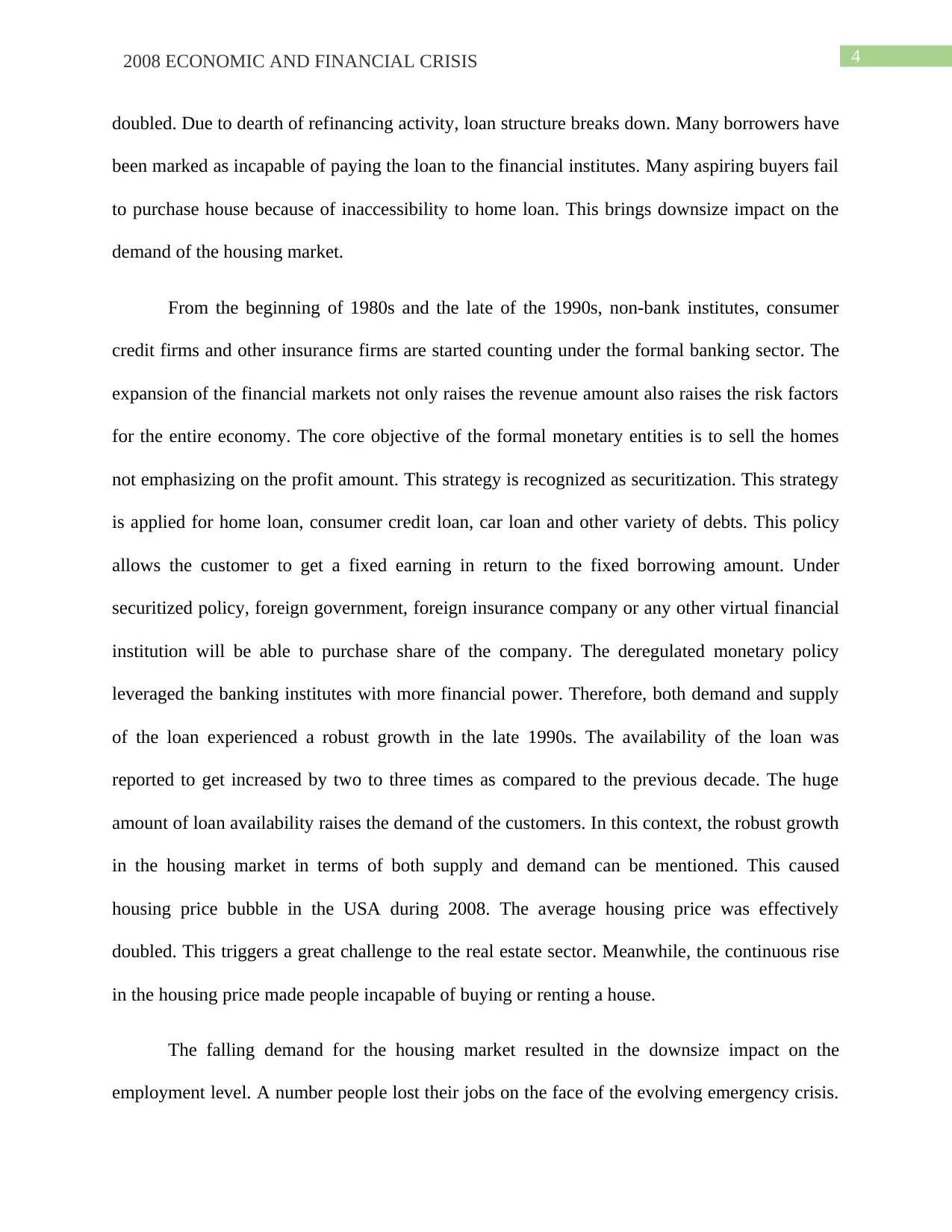
42008 ECONOMIC AND FINANCIAL CRISIS
doubled. Due to dearth of refinancing activity, loan structure breaks down. Many borrowers have
been marked as incapable of paying the loan to the financial institutes. Many aspiring buyers fail
to purchase house because of inaccessibility to home loan. This brings downsize impact on the
demand of the housing market.
From the beginning of 1980s and the late of the 1990s, non-bank institutes, consumer
credit firms and other insurance firms are started counting under the formal banking sector. The
expansion of the financial markets not only raises the revenue amount also raises the risk factors
for the entire economy. The core objective of the formal monetary entities is to sell the homes
not emphasizing on the profit amount. This strategy is recognized as securitization. This strategy
is applied for home loan, consumer credit loan, car loan and other variety of debts. This policy
allows the customer to get a fixed earning in return to the fixed borrowing amount. Under
securitized policy, foreign government, foreign insurance company or any other virtual financial
institution will be able to purchase share of the company. The deregulated monetary policy
leveraged the banking institutes with more financial power. Therefore, both demand and supply
of the loan experienced a robust growth in the late 1990s. The availability of the loan was
reported to get increased by two to three times as compared to the previous decade. The huge
amount of loan availability raises the demand of the customers. In this context, the robust growth
in the housing market in terms of both supply and demand can be mentioned. This caused
housing price bubble in the USA during 2008. The average housing price was effectively
doubled. This triggers a great challenge to the real estate sector. Meanwhile, the continuous rise
in the housing price made people incapable of buying or renting a house.
The falling demand for the housing market resulted in the downsize impact on the
employment level. A number people lost their jobs on the face of the evolving emergency crisis.
doubled. Due to dearth of refinancing activity, loan structure breaks down. Many borrowers have
been marked as incapable of paying the loan to the financial institutes. Many aspiring buyers fail
to purchase house because of inaccessibility to home loan. This brings downsize impact on the
demand of the housing market.
From the beginning of 1980s and the late of the 1990s, non-bank institutes, consumer
credit firms and other insurance firms are started counting under the formal banking sector. The
expansion of the financial markets not only raises the revenue amount also raises the risk factors
for the entire economy. The core objective of the formal monetary entities is to sell the homes
not emphasizing on the profit amount. This strategy is recognized as securitization. This strategy
is applied for home loan, consumer credit loan, car loan and other variety of debts. This policy
allows the customer to get a fixed earning in return to the fixed borrowing amount. Under
securitized policy, foreign government, foreign insurance company or any other virtual financial
institution will be able to purchase share of the company. The deregulated monetary policy
leveraged the banking institutes with more financial power. Therefore, both demand and supply
of the loan experienced a robust growth in the late 1990s. The availability of the loan was
reported to get increased by two to three times as compared to the previous decade. The huge
amount of loan availability raises the demand of the customers. In this context, the robust growth
in the housing market in terms of both supply and demand can be mentioned. This caused
housing price bubble in the USA during 2008. The average housing price was effectively
doubled. This triggers a great challenge to the real estate sector. Meanwhile, the continuous rise
in the housing price made people incapable of buying or renting a house.
The falling demand for the housing market resulted in the downsize impact on the
employment level. A number people lost their jobs on the face of the evolving emergency crisis.
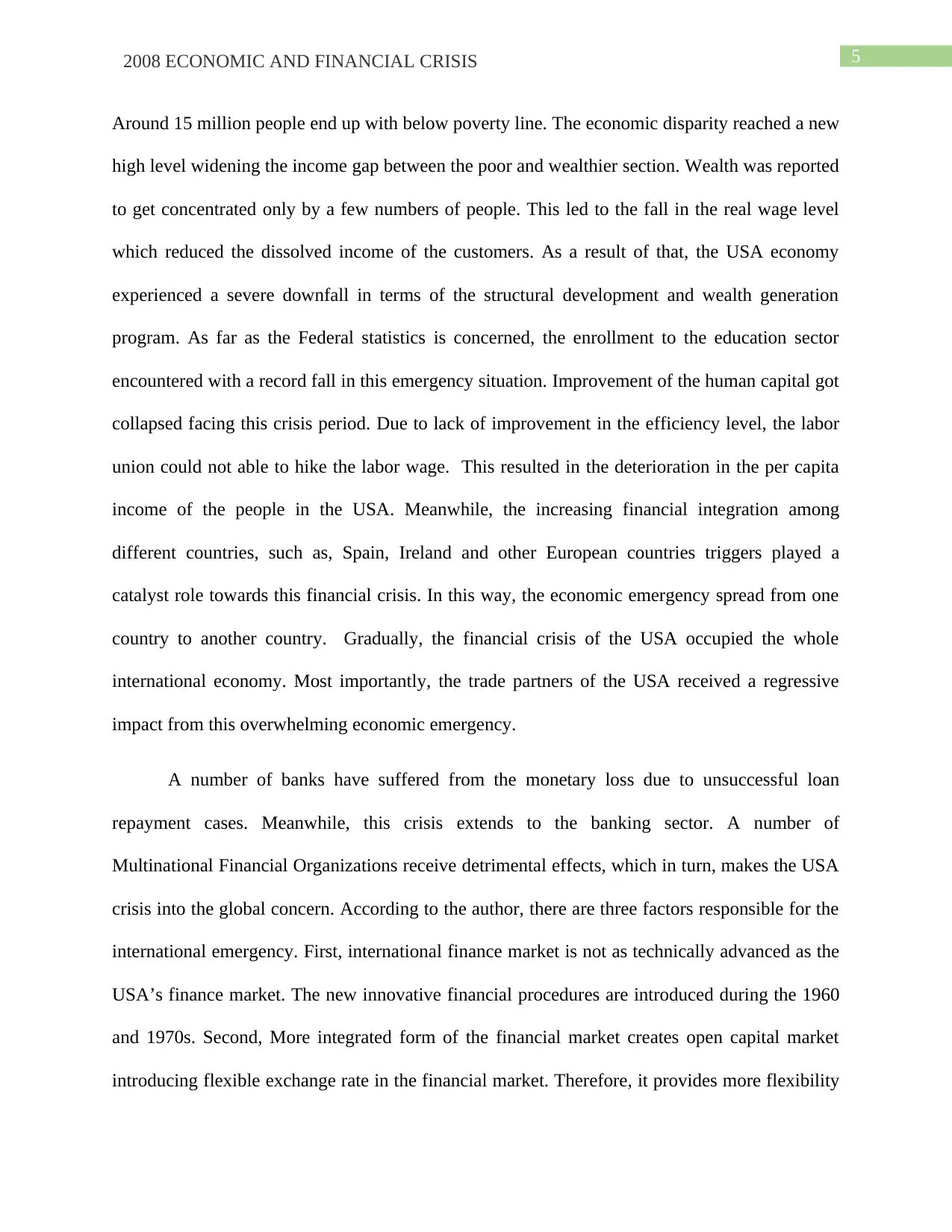
52008 ECONOMIC AND FINANCIAL CRISIS
Around 15 million people end up with below poverty line. The economic disparity reached a new
high level widening the income gap between the poor and wealthier section. Wealth was reported
to get concentrated only by a few numbers of people. This led to the fall in the real wage level
which reduced the dissolved income of the customers. As a result of that, the USA economy
experienced a severe downfall in terms of the structural development and wealth generation
program. As far as the Federal statistics is concerned, the enrollment to the education sector
encountered with a record fall in this emergency situation. Improvement of the human capital got
collapsed facing this crisis period. Due to lack of improvement in the efficiency level, the labor
union could not able to hike the labor wage. This resulted in the deterioration in the per capita
income of the people in the USA. Meanwhile, the increasing financial integration among
different countries, such as, Spain, Ireland and other European countries triggers played a
catalyst role towards this financial crisis. In this way, the economic emergency spread from one
country to another country. Gradually, the financial crisis of the USA occupied the whole
international economy. Most importantly, the trade partners of the USA received a regressive
impact from this overwhelming economic emergency.
A number of banks have suffered from the monetary loss due to unsuccessful loan
repayment cases. Meanwhile, this crisis extends to the banking sector. A number of
Multinational Financial Organizations receive detrimental effects, which in turn, makes the USA
crisis into the global concern. According to the author, there are three factors responsible for the
international emergency. First, international finance market is not as technically advanced as the
USA’s finance market. The new innovative financial procedures are introduced during the 1960
and 1970s. Second, More integrated form of the financial market creates open capital market
introducing flexible exchange rate in the financial market. Therefore, it provides more flexibility
Around 15 million people end up with below poverty line. The economic disparity reached a new
high level widening the income gap between the poor and wealthier section. Wealth was reported
to get concentrated only by a few numbers of people. This led to the fall in the real wage level
which reduced the dissolved income of the customers. As a result of that, the USA economy
experienced a severe downfall in terms of the structural development and wealth generation
program. As far as the Federal statistics is concerned, the enrollment to the education sector
encountered with a record fall in this emergency situation. Improvement of the human capital got
collapsed facing this crisis period. Due to lack of improvement in the efficiency level, the labor
union could not able to hike the labor wage. This resulted in the deterioration in the per capita
income of the people in the USA. Meanwhile, the increasing financial integration among
different countries, such as, Spain, Ireland and other European countries triggers played a
catalyst role towards this financial crisis. In this way, the economic emergency spread from one
country to another country. Gradually, the financial crisis of the USA occupied the whole
international economy. Most importantly, the trade partners of the USA received a regressive
impact from this overwhelming economic emergency.
A number of banks have suffered from the monetary loss due to unsuccessful loan
repayment cases. Meanwhile, this crisis extends to the banking sector. A number of
Multinational Financial Organizations receive detrimental effects, which in turn, makes the USA
crisis into the global concern. According to the author, there are three factors responsible for the
international emergency. First, international finance market is not as technically advanced as the
USA’s finance market. The new innovative financial procedures are introduced during the 1960
and 1970s. Second, More integrated form of the financial market creates open capital market
introducing flexible exchange rate in the financial market. Therefore, it provides more flexibility
⊘ This is a preview!⊘
Do you want full access?
Subscribe today to unlock all pages.

Trusted by 1+ million students worldwide
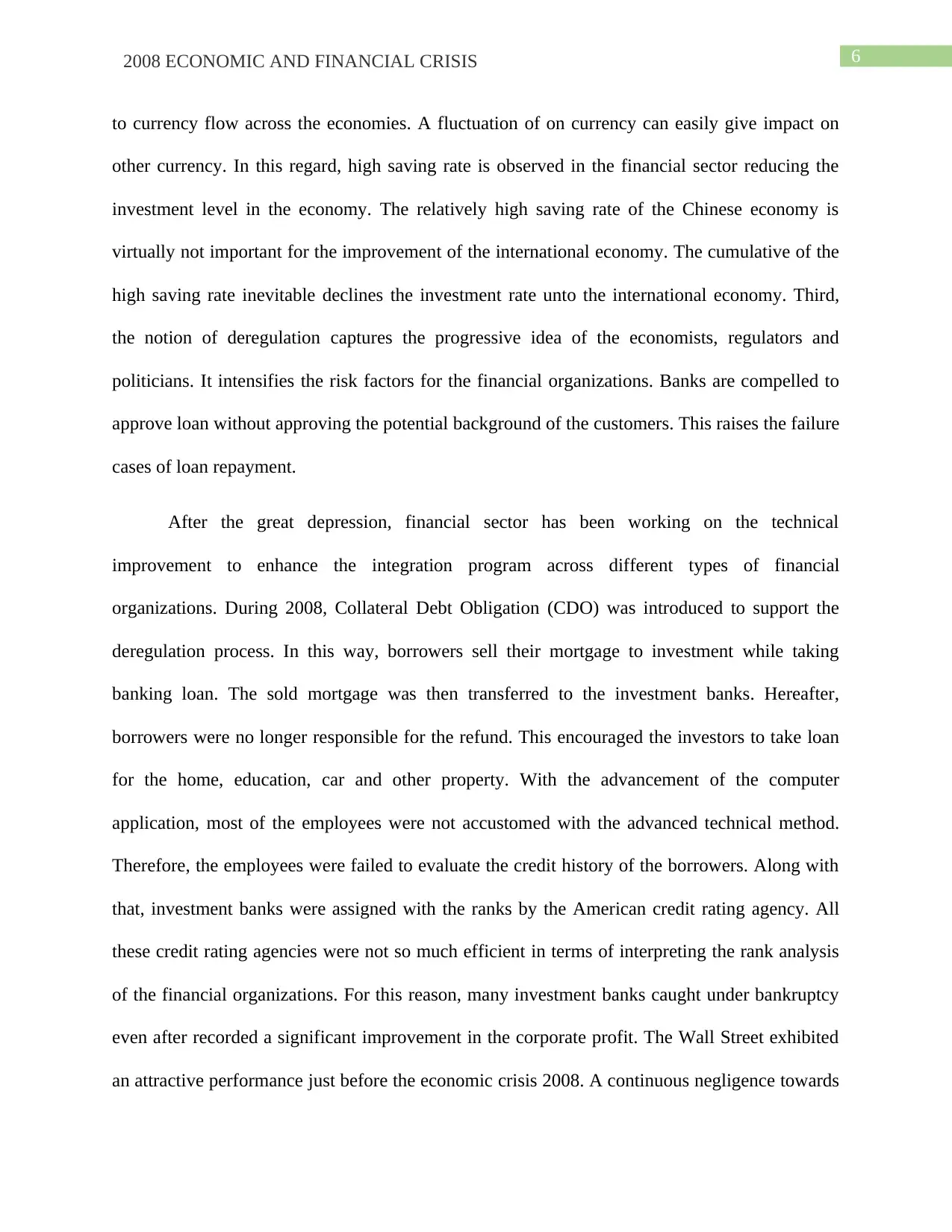
62008 ECONOMIC AND FINANCIAL CRISIS
to currency flow across the economies. A fluctuation of on currency can easily give impact on
other currency. In this regard, high saving rate is observed in the financial sector reducing the
investment level in the economy. The relatively high saving rate of the Chinese economy is
virtually not important for the improvement of the international economy. The cumulative of the
high saving rate inevitable declines the investment rate unto the international economy. Third,
the notion of deregulation captures the progressive idea of the economists, regulators and
politicians. It intensifies the risk factors for the financial organizations. Banks are compelled to
approve loan without approving the potential background of the customers. This raises the failure
cases of loan repayment.
After the great depression, financial sector has been working on the technical
improvement to enhance the integration program across different types of financial
organizations. During 2008, Collateral Debt Obligation (CDO) was introduced to support the
deregulation process. In this way, borrowers sell their mortgage to investment while taking
banking loan. The sold mortgage was then transferred to the investment banks. Hereafter,
borrowers were no longer responsible for the refund. This encouraged the investors to take loan
for the home, education, car and other property. With the advancement of the computer
application, most of the employees were not accustomed with the advanced technical method.
Therefore, the employees were failed to evaluate the credit history of the borrowers. Along with
that, investment banks were assigned with the ranks by the American credit rating agency. All
these credit rating agencies were not so much efficient in terms of interpreting the rank analysis
of the financial organizations. For this reason, many investment banks caught under bankruptcy
even after recorded a significant improvement in the corporate profit. The Wall Street exhibited
an attractive performance just before the economic crisis 2008. A continuous negligence towards
to currency flow across the economies. A fluctuation of on currency can easily give impact on
other currency. In this regard, high saving rate is observed in the financial sector reducing the
investment level in the economy. The relatively high saving rate of the Chinese economy is
virtually not important for the improvement of the international economy. The cumulative of the
high saving rate inevitable declines the investment rate unto the international economy. Third,
the notion of deregulation captures the progressive idea of the economists, regulators and
politicians. It intensifies the risk factors for the financial organizations. Banks are compelled to
approve loan without approving the potential background of the customers. This raises the failure
cases of loan repayment.
After the great depression, financial sector has been working on the technical
improvement to enhance the integration program across different types of financial
organizations. During 2008, Collateral Debt Obligation (CDO) was introduced to support the
deregulation process. In this way, borrowers sell their mortgage to investment while taking
banking loan. The sold mortgage was then transferred to the investment banks. Hereafter,
borrowers were no longer responsible for the refund. This encouraged the investors to take loan
for the home, education, car and other property. With the advancement of the computer
application, most of the employees were not accustomed with the advanced technical method.
Therefore, the employees were failed to evaluate the credit history of the borrowers. Along with
that, investment banks were assigned with the ranks by the American credit rating agency. All
these credit rating agencies were not so much efficient in terms of interpreting the rank analysis
of the financial organizations. For this reason, many investment banks caught under bankruptcy
even after recorded a significant improvement in the corporate profit. The Wall Street exhibited
an attractive performance just before the economic crisis 2008. A continuous negligence towards
Paraphrase This Document
Need a fresh take? Get an instant paraphrase of this document with our AI Paraphraser
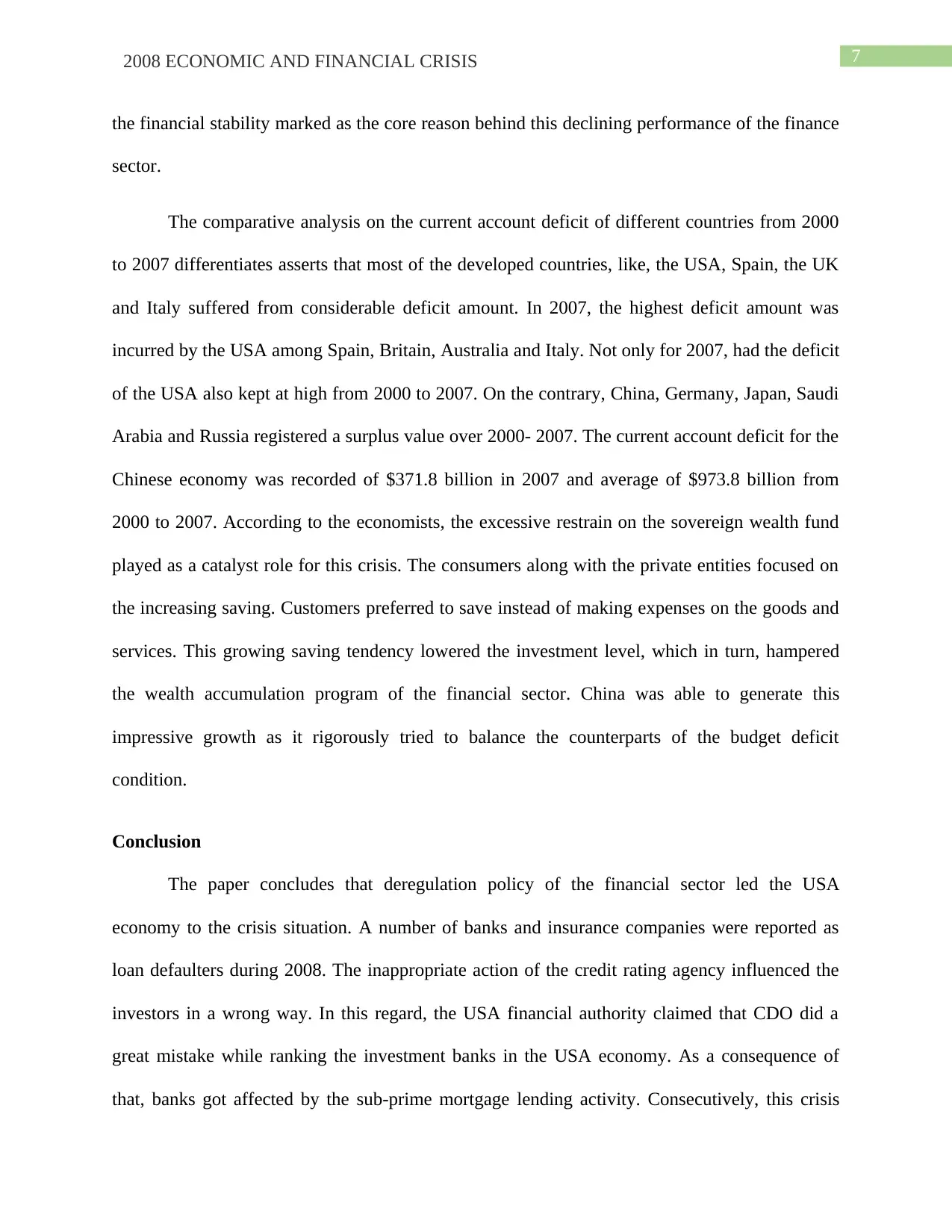
72008 ECONOMIC AND FINANCIAL CRISIS
the financial stability marked as the core reason behind this declining performance of the finance
sector.
The comparative analysis on the current account deficit of different countries from 2000
to 2007 differentiates asserts that most of the developed countries, like, the USA, Spain, the UK
and Italy suffered from considerable deficit amount. In 2007, the highest deficit amount was
incurred by the USA among Spain, Britain, Australia and Italy. Not only for 2007, had the deficit
of the USA also kept at high from 2000 to 2007. On the contrary, China, Germany, Japan, Saudi
Arabia and Russia registered a surplus value over 2000- 2007. The current account deficit for the
Chinese economy was recorded of $371.8 billion in 2007 and average of $973.8 billion from
2000 to 2007. According to the economists, the excessive restrain on the sovereign wealth fund
played as a catalyst role for this crisis. The consumers along with the private entities focused on
the increasing saving. Customers preferred to save instead of making expenses on the goods and
services. This growing saving tendency lowered the investment level, which in turn, hampered
the wealth accumulation program of the financial sector. China was able to generate this
impressive growth as it rigorously tried to balance the counterparts of the budget deficit
condition.
Conclusion
The paper concludes that deregulation policy of the financial sector led the USA
economy to the crisis situation. A number of banks and insurance companies were reported as
loan defaulters during 2008. The inappropriate action of the credit rating agency influenced the
investors in a wrong way. In this regard, the USA financial authority claimed that CDO did a
great mistake while ranking the investment banks in the USA economy. As a consequence of
that, banks got affected by the sub-prime mortgage lending activity. Consecutively, this crisis
the financial stability marked as the core reason behind this declining performance of the finance
sector.
The comparative analysis on the current account deficit of different countries from 2000
to 2007 differentiates asserts that most of the developed countries, like, the USA, Spain, the UK
and Italy suffered from considerable deficit amount. In 2007, the highest deficit amount was
incurred by the USA among Spain, Britain, Australia and Italy. Not only for 2007, had the deficit
of the USA also kept at high from 2000 to 2007. On the contrary, China, Germany, Japan, Saudi
Arabia and Russia registered a surplus value over 2000- 2007. The current account deficit for the
Chinese economy was recorded of $371.8 billion in 2007 and average of $973.8 billion from
2000 to 2007. According to the economists, the excessive restrain on the sovereign wealth fund
played as a catalyst role for this crisis. The consumers along with the private entities focused on
the increasing saving. Customers preferred to save instead of making expenses on the goods and
services. This growing saving tendency lowered the investment level, which in turn, hampered
the wealth accumulation program of the financial sector. China was able to generate this
impressive growth as it rigorously tried to balance the counterparts of the budget deficit
condition.
Conclusion
The paper concludes that deregulation policy of the financial sector led the USA
economy to the crisis situation. A number of banks and insurance companies were reported as
loan defaulters during 2008. The inappropriate action of the credit rating agency influenced the
investors in a wrong way. In this regard, the USA financial authority claimed that CDO did a
great mistake while ranking the investment banks in the USA economy. As a consequence of
that, banks got affected by the sub-prime mortgage lending activity. Consecutively, this crisis
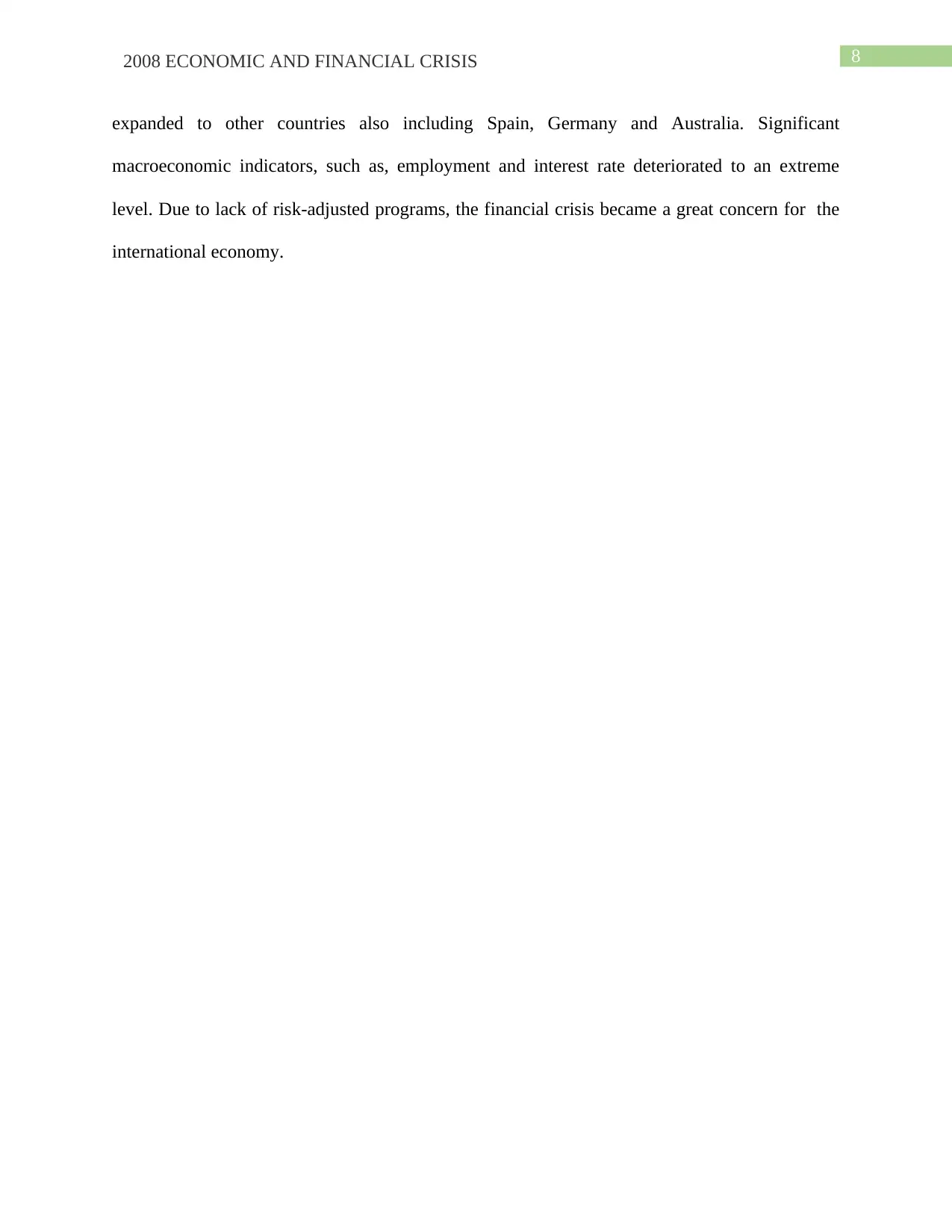
82008 ECONOMIC AND FINANCIAL CRISIS
expanded to other countries also including Spain, Germany and Australia. Significant
macroeconomic indicators, such as, employment and interest rate deteriorated to an extreme
level. Due to lack of risk-adjusted programs, the financial crisis became a great concern for the
international economy.
expanded to other countries also including Spain, Germany and Australia. Significant
macroeconomic indicators, such as, employment and interest rate deteriorated to an extreme
level. Due to lack of risk-adjusted programs, the financial crisis became a great concern for the
international economy.
⊘ This is a preview!⊘
Do you want full access?
Subscribe today to unlock all pages.

Trusted by 1+ million students worldwide
1 out of 9
Related Documents
Your All-in-One AI-Powered Toolkit for Academic Success.
+13062052269
info@desklib.com
Available 24*7 on WhatsApp / Email
![[object Object]](/_next/static/media/star-bottom.7253800d.svg)
Unlock your academic potential
Copyright © 2020–2025 A2Z Services. All Rights Reserved. Developed and managed by ZUCOL.




